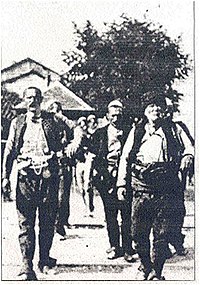| Idriz Seferi | |
|---|---|
 | |
| Born | March 14, 1847 |
| Died | March 25, 1927 (aged 80) |
| Place of birth | Sefer, Karadak, Kosovo Vilayet |
| Allegiance |
League of Prizren League of Peja |
| Service/branch | Kachak |
| Years of service | 1878–1918 |
| Rank | Commander |
| Commands held | Kachak |
| Battles/wars |
Albanian Revolt of 1910 Albanian Revolt of 1912 Albania during the Balkan Wars |
| Awards | Hero of Kosovo |
Idriz Seferi (1847-1927) was an Albanian nationalist figure and guerrilla fighter.
Biography[]
Early period[]
Idriz Seferi was born in the village of Sefer in the Karadak Mountains north of Üsküb.[1] He was born into a well known patriotic family and at an early age he joined Albanian National Movement.[2]
Albanian uprising[]

Idriz Seferi and his guerrillas entering Ferizaj
He took part in the League of Prizren and the League of Peja. Comrade in arms of Isa Boletini, Seferi was one of the leaders of the uprising in Kosovo in 1910, when he took over Gjilan and commanded a garrison of 5,000 who resisted Ottoman forces in the gorge of Kaçanik Pass. Seferi held the pass for more than a fortnight and inflicted heavy losses on the Turkish army despite the fact that they were without artillery. They were driven from it by the troops only after a desperate battle lasting thirteen hours, for they were greatly outnumbered.[1][3] There he and his men stopped a train carrying soldiers and supplies bound for Pristina, carried off the supplies and disarmed the soldiers.[1] He also took part in the general uprising in Kosovo in 1912 when he organized resistance in the Ferizaj area, where fiercest fighting took place.
On the 12th of August, 1912, Unable to wait any longer for the Turkish acceptance of all the demands of the League, 30,000 Albanian irregulars, the forces of chieftains Bajram Curri, Hasan Prishtina, Mehmet Dërralla, Riza Gjakova and Idriz Seferi, united among themselves under the command of Isa Boletini and advanced towards Üsküb, the capital of the Vilayet of Kosovo, which they entered without encountering any resistance and took possession.[3] As the national uprising spread throughout Kosovo and most of the north, troops were sent against the rebels, who retired to the mountains but continued to protest against the government, and in the whole region between Ipek and Mitrovica they plundered military depot, opened prisons and collected taxes from the inhabitants for the Albanian chiefs.[3]
Balkan Wars[]
He continued his struggle for the liberation of Kosovo in 1913-1915 after the Serbian occupation and, in 1916-1918, against Bulgarian forces. Although a guerrilla fighter of great repute in Kosovo, Idriz Seferi died peacefully in his bed.[1]
References[]
- ↑ 1.0 1.1 1.2 1.3 Elsie, Robert (2012). A Biographical Dictionary of Albanian History. London: I.B.Tauris & Co. Ltd.. p. 403. ISBN 978-1-78076-431-3. http://books.google.com.au/books?id=pgf6GWJxuZgC&pg=PA403&dq=idriz+seferi&hl=en&sa=X&ei=5b_aUaiFD4SmkAXU34HIDQ&ved=0CDwQ6AEwAw#v=onepage&q=idriz%20seferi&f=false. Retrieved 8 July 2013.
- ↑ Bep Jubani et al., Historia e popullit shqiptar: për shkollat e mesme (Libri Shkollor: Prishtinë, 2002) 191-198.
- ↑ 3.0 3.1 3.2 Pearsons, Owen (2004). Albania in the Twentieth Century: A History, Volume 1. London: I.B.Tauris & Co. Ltd.. p. 24. ISBN 1-84511-013-7. http://books.google.com.au/books?id=3_Sh3y9IMZAC&pg=PA26&dq=idriz+seferi&hl=en&sa=X&ei=5b_aUaiFD4SmkAXU34HIDQ&ved=0CFcQ6AEwCA#v=onepage&q=idriz%20seferi&f=false. Retrieved 8 July 2013.
The original article can be found at Idriz Seferi and the edit history here.